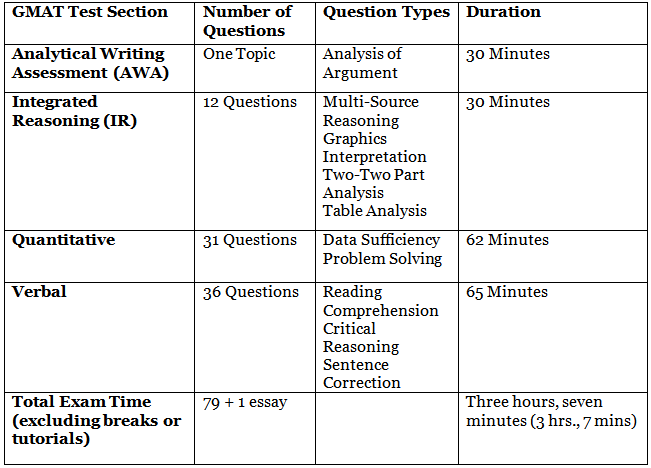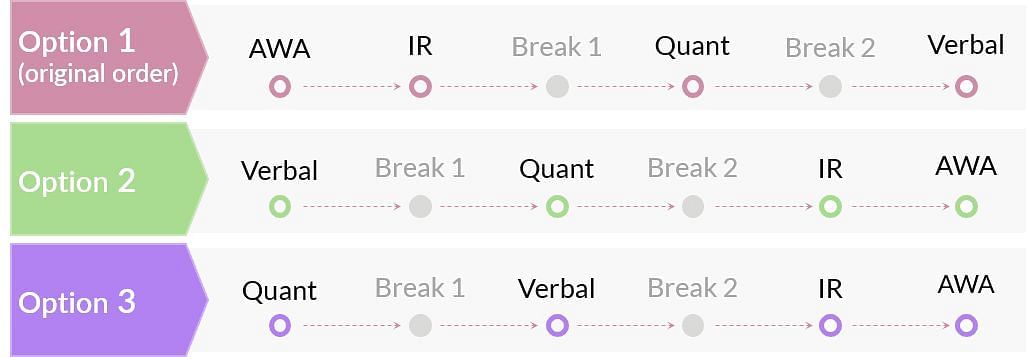GMAT Exam Pattern 2025 PDF Download
The GMAT, or Graduate Management Admission Test, is a standardized test that is widely used for admission to graduate-level management programs, including MBA programs. As with any standardized test, the GMAT exam is regularly updated to ensure that it remains a relevant and effective tool for assessing candidates' aptitude for business studies. As we look ahead to 2023, it's worth examining the changes and updates that have been made to the GMAT exam pattern, including the number and type of sections, the question types, and the overall scoring system. Whether you are a prospective MBA student, a test preparation professional, or simply interested in keeping up with the latest trends in graduate admissions testing, understanding the GMAT 2023 exam pattern is a critical step.

GMAT exam: Important Highlights
Features | Details |
GMAT full form | Graduate Management Admission Test |
Year Started | 1973 |
Exam Level | Global |
GMAT 2023 exam date | There are no specific dates when for taking the GMAT, which is the most unique thing about GMAT as the candidates have the option to take the test on any available date and time that works best for them. |
GMAT Exam Pattern | Computer-based test with MCQs for each section except AWA, where an essay is to be written. Verbal section also consists of fill-in-the-blank type MCQs. |
GMAT 2023 Exam Date | Offered year-round at designated testing centers and online |
Duration of GMAT Exam | 3 hours and 7 minutes, and two optional 8-minute breaks |
Duration (Section-wise) | Verbal (65 minutes) |
Quantitative (62 minutes) | |
Integrated Reasoning (30 minutes) | |
Analytical Writing Assessment (30 minutes) | |
Eligibility | Candidates must hold a bachelor's degree from an accredited institution. Candidates between the age of 13-17 require parental consent. |
No. of Questions | 80 questions |
No. of Questions Section-wise | Verbal Reasoning - 36 |
Quantitative Aptitude - 31 | |
Integrated Reasoning - 12 | |
Analytical Writing Assessment - 1(essay) | |
Total Score | 800 |
Score per section | Verbal Reasoning - 6-51 (1 point increments) |
Quantitative Aptitude - 6-51 (1 point increments) | |
Integrated Reasoning - 1-8 (1 point increments) | |
Analytical Writing Assessment - 0.0-6.0 (0.5 point increments) | |
Exam purpose | Admissions to more than 7,700 programs at 2,400 universities and organizations in 110 countries. |
GMAT Exam Pattern 2023
- There will be four distinct sections in the upcoming test, which are the writing assessment, quantitative ability, verbal, and integrated reasoning.
- Each of these sections will have its own time limits, during which candidates will need to answer the questions.
- The actual amount of time a candidate has to complete the test is 3 hours and 7 minutes.
GMAT Exam Pattern 2023: Latest Changes
In the new GMAT format, the GMAT test is shorter by 30 minutes (made effective from April 16, 2018). GMAC has reduced the total time duration of the GMAT from 4 hours to 3.5 hours. The change in this new format has been made in the Tutorial Screens and the Quant and Verbal Section (scored out of 800).
What is meant by computer adaptive nature of GMAT
The GMAT 2023 exam pattern's sections on quantitative and verbal reasoning are designed to be computer-adaptive. - This means that the test's difficulty level adapts to the candidate's ability to answer questions, making it a highly precise assessment of their potential.
- In these sections, the first question presented will be of medium difficulty, and as the candidate answers, the computer scores their responses and uses them, along with any preceding answers, to determine the next question.
- If the candidate answers correctly, the next question will be more challenging, but if they answer incorrectly, the next question will be of moderate difficulty.
- This process continues until the candidate completes the section, allowing them to demonstrate their full potential.
- It's important to note that the computer-adaptive nature of the exam pattern means that candidates cannot skip, return to, or modify their answers to any question, as the responses to each question influence the selection of the next one.
To learn more about Computer Adaptive exams in detail, refer to EduRev’s article What is a Computer Adaptive Test?
GMAT Exam Section-Wise Pattern
The GMAT exam is divided into four sections: Analytical Writing Assessment (AWA), Integrated Reasoning (IR), Quantitative, and Verbal.
The following table provides a comprehensive breakdown of these sections.

GMAT Exam Sections Order Selection

The original order before GMAC introduced the “Select Section Order” feature was: “Analytical Writing Assessment, Integrated Reasoning, Quantitative, Verbal”. Now, there are three options from which you can take the GMAT: The Select Section Order feature was designed to allow GMAT test-takers to put their best foot forward and take the test based on their strengths and testing preferences. This is GMAC’s attempt to help you build comfort and confidence on exam day. You can choose the order in which you want to take the GMAT sections, just before your exam begins.
- Original Order – Analytical Writing Assessment, Integrated Reasoning, <Break 1>, Quantitative, <Break 2>, Verbal
- Verbal, <Break 1>, Quantitative, <Break 2>, Integrated Reasoning, Analytical Writing Assessment
- Quantitative, <Break 1>, Verbal, <Break 2>, Integrated Reasoning, Analytical Writing Assessment
As per GMAC, “There is no “correct” or “recommended” section order to select. This choice gives you more control and flexibility.” For more details, please refer to this article on GMAT Exam Format – Select Section Order.
GMAT Structure – GMAT Exam pattern
| Order 2 | Order 3 |
Analytical Writing Assessment | Verbal | Quantitative |
Integrated Reasoning | ||
8-min break (optional) | ||
Quantitative | Quantitative | Verbal |
8-min break (optional) | ||
Verbal | Integrated Reasoning | Integrated Reasoning |
Analytical Writing Assessment | Analytical Writing Assessment |
GMAT Exam Syllabus 2023
Many MBA aspirants, across the globe, appear for the GMAT exam. It is the basis to get them in their dream business school. A 3 hour 7 minute test with a minimum score of 800 points is divided into four sections, namely:
Though the GMAT exam syllabus of the four sections is comprehensive, yet it is defined. By following a structured study plan, it is possible to complete the entire exam syllabus within 4 to 5 months.
Quantitative Reasoning
The GMAT quantitative reasoning section evaluates the aspirant’s capacity to solve quantitative problems and interpret graphical data. It has 2 parts with multiple-choice questions:
- Problem-Solving
- Data Sufficiency
Acing this section requires basic knowledge of arithmetic, elementary algebra, and commonly known concepts of geometry. Refer to the table below for the complete quant syllabus:
Arithmetic | Algebra | Geometry |
Functions | Lines and Angles | |
Multiples & Factors | Exponents | Triangle |
Decimals | Statistics | Quadrilaterals |
Fractions | Arithmetic & Geometric Progression | Circles |
Average | Algebraic Expressions & Equations | Coordinate Geometry |
Percentage | Permutation & Combination | |
Speed, Time, Distance | ||
Simple & Compound Interest | ||
Ratio & Proportion | ||
Probability |
Verbal Reasoning
The GMAT verbal reasoning section measures the candidate’s ability to read and comprehend, reason and logically evaluate the presented arguments in passages. It consists of 3 parts, each with numerous multiple-choice questions:
- Critical Reasoning – It is the test to analyze an individual’s ability to reason logically through an argument and answer objectively, while avoiding personal opinion when attempting to answer the question.
- Reading Comprehension – This is a test designed to evaluate the aspirant’s ability to read and comprehend the concepts quickly. The given passages are generally between 200–350 words, and have multiple questions to answer. The candidates are tested on the following reading skills:
Interpretation of the information in the given passages
Understanding the main idea
Forming a logical structure
Following the development of quantitative concepts - Sentence Correction: This part is a single-sentence correction question, and the words with errors are underlined. It measures an individual’s language proficiency by testing:
- Their efficiency to correct the sentence grammatically and structurally correct.
- Their understanding of effective and concise expression of an idea.
The areas covered in GMAT Verbal Reasoning are:
- Reading unfamiliar passages
- Critical reasoning
- Rhetorical sentence construction
- Finding omissions or errors in sentences
- Subject vs verb agreement
- Modifiers
- Countable and uncountable
- Parallelism
Analytical Writing Assessment
The GMAT analytical writing assessment section is a test of your writing style. You will be asked only 1 question in this section. In a limited time of 30 minutes, you have to comprehend, analyze, think quickly and critically, and write the essay, reinforcing the idea with the facts and logical examples.
Integrated Reasoning
The GMAT integrated reasoning section evaluates your ability to understand and evaluate multiple sources and types of information – graphic, verbal or numeric – in relation to each other. It is a test designed to examine your capacity to assess the facts and figures presented as graphs and tables.
This section is divided into 4 parts with 12 questions:
- Table Analysis: It tests your ability to sort and analyze data.
- Graphic Interpretation: It tests your ability to interpret information presented in a graph.
- Multi-source Reasoning: It tests your potential to understand and evaluate data from a combination of different sources – tables, graphics, and text
- Two-Part Analysis: It presents complex problems that can either be verbal, quantitative or a combination of both.
Now that you have detailed information about the GMAT syllabus, we are sure it would help you prepare for the exam better.
For further assistance with preparation material and live classes, check out iQuanta’s GMAT courses.
GMAT exam section-wise score weightage
The GMAT exam, which is administered by GMAC, has a score range of 200 to 800, with an average total score of 565. It is noteworthy that around two-thirds of test-takers score between 400 and 600, as per GMAC.The breakdown for each of the sections of GMAT is given below.

Also Read: GMAT Syllabus 2023
 |
Download the notes
GMAT Exam Pattern 2025
|
Download as PDF |
Frequently Asked Questions (FAQs) about GMAT exam pattern
What is the GMAT exam pattern?
The GMAT exam pattern consists of four sections, which include analytical writing, integrated reasoning, quantitative reasoning, and verbal reasoning.
How is the GMAT exam scored?
The GMAT exam is scored on a scale of 200-800, with higher scores indicating stronger performance. The analytical writing and integrated reasoning sections are scored on a scale of 0-6, while the quantitative and verbal reasoning sections are scored on a scale of 0-60.
How long is the GMAT exam?
The complete GMAT exam, including check-in, check-out, and two breaks, takes 3 hours and 30 minutes. However, the effective test duration is 3 hours and 7 minutes.
Can I take the GMAT exam online?
Yes, the GMAT exam is available in an online format. However, certain restrictions and requirements apply, and online testing is not available in all regions.
Can I retake the GMAT exam?
Yes, you can retake the GMAT exam. There is a limit of five attempts in a 12-month period, with a minimum gap of 16 days between attempts.
Is the GMAT exam computer-adaptive?
Yes, the quantitative and verbal reasoning sections of the GMAT exam are computer-adaptive, meaning that the difficulty level of the test changes based on the candidate's ability to answer the questions.
How do I prepare for the GMAT exam?
There are several resources available to help prepare for the GMAT exam, including online study guides, practice tests etc. It's important to establish a study plan and allow sufficient time to prepare thoroughly. One such resource you can use is EduRev. EduRev’s infinity pack for GMAT preparation offers videos, notes, practice questions, mock tests, and much more.





















